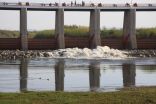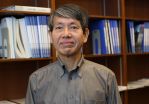(Press-News.org) VIDEO:
Using data from NASA/USGS satellite Landsat 8, scientists have measured how vegetation in the Colorado River Delta has responded to the pulse of water released in March 2014 as part...
Click here for more information.
A pulse of water released down the lower reaches of the Colorado River last spring resulted in more than a 40 percent increase in green vegetation where the water flowed, as seen by the Landsat 8 satellite. The March 2014 release of water - an experimental flow implemented under a U.S.-Mexico agreement called "Minute 319" - reversed a 13-year decline in the greenness along the delta.
The year 2000 was the last time the Colorado River reached the Sea of Cortez, between Mexico's mainland and Baja California. Since then, said Pamela Nagler of the U.S. Geological Survey's Southwest Biological Science Center in Tucson, Arizona, information from ground measurements and satellites, including NASA/USGS's Landsat missions and the Moderate Resolution Imaging Spectroradiometer, or MODIS, instrument on NASA's Terra satellite, have shown a decline in the amount of healthy vegetation along the lower reaches of the river.
This spring's pulse flow brought back some of the green. Nagler and other members of the Minute 319 Science Team used Landsat 8's sensors to track the response of plants to the pulse of water. Landsat 8 is a joint project of NASA and the U.S. Geological Survey (USGS).
"The vegetation that desperately needed water was finally able to support more green leaves," Nagler said. "These are existing trees, like saltcedar, willow and cottonwood, and a lot of shrubs and grasses that hadn't seen much water in a long time."
When they compared satellite images of pre-flow August 2013 to post-flow August 2014, the researchers calculated a 43 percent increase in green vegetation along the route wetted by the flow, called the inundation zone, and a 23 percent increase in greening of the riparian zone, or the river banks. Scientists presented these and other results this week at the American Geophysical Union's Fall Meeting in San Francisco.
"Data from Landsat and the MODIS sensor are well-suited to help people make informed policy decisions about ecosystem health, water management, agriculture and much more," said Jim Irons, Landsat 8 project scientist at NASA's Goddard Space Flight Center in Greenbelt, Maryland. "It's especially gratifying to see these sensors help scientists evaluate several of those components in one project," he said. Remote sensing data were used in studies showing the impact of other relatively small flows prior to the Minute 319 agreement, and researchers are currently using Landsat 8 and MODIS to continue studying the effects of the 2014 water release.
Irons said that projects like this one demonstrate that researchers need an archive of good Earth observations of the past to refer to, as well as comparable measurements into the future to measure how a policy changes the landscape. "It's important to have continuity of the data, so that when a policy decision is made to release the water, we have a system in place to evaluate its effects," he said.
The Minute 319 pulse flow is part of an agreement adopted by the International Boundary and Water Commission, under the framework of a 1944 U.S.- Mexico treaty that governs water allocations on the Colorado River between the two countries. The 2012 agreement prescribed 130 million cubic meters (105,000 acre feet) of water to flow through Morelos Dam, which straddles the border.
Although most of the water soaked into the ground in the 37 miles below the dam, the river's surface flow reached areas farther downstream that had been targeted for restoration, and groundwater revived vegetation along the entire route to the sea.
"Remote sensing with satellites such as Landsat and sensors such as MODIS allows scientists to conduct a range of studies they wouldn't otherwise be able to," said Karl Flessa, the co-chief scientist of the Minute 319 Science Team studying the hydrologic and biologic effects, and a geosciences professor at the University of Arizona in Tucson.
It's just one of the tools scientists are using, along with on-the-ground monitoring, to detect changes in the river channel, surface water, groundwater, plant growth, and habitat for resident marsh birds and migratory birds.
"In addition to remote sensing, ground-based geophysical methods such as time-lapse gravity maps provide information about the change in groundwater storage, which ultimately supports riparian vegetation," said Jeff Kennedy, USGS hydrologist and participant in the study.
The Minute 319 pulse flow was the result of significant cooperation between a large group of partner organizations and agencies in the U.S. and Mexico.
With so many interested parties, and water such a precious resource, scientists will continue to monitor the lower Colorado River Delta's vegetation and hydrological response to the pulse flow, Flessa said. Using greenness data collected both from the ground and from satellites, researchers will investigate the long-term impacts to groundwater, and they'll continue to study whether new trees and shrubs take root due to the flow. They will also study how the new vegetation affects birds migrating along the Pacific Flyway.
"There's hope that we could release a pulse of water below Morelos Dam again," Flessa said.
INFORMATION:
Hydrogen fuel is a promising source of clean energy that can be produced by splitting water into hydrogen and oxygen gas. The reaction is difficult but achievable with the help of a catalyst, a material that can speed up the process. However, current catalysts lack the efficiency required for water splitting to be commercially competitive. Recently scientists have identified one such catalyst, iron-doped nickel oxide, as a highly active compound that can speed up this reaction, but the origin of its activity is not well understood.
Now researchers at Princeton University ...
The United States is a melting pot of different racial and ethnic groups, but it has not been clear how the genetic ancestry of these populations varies across different geographic regions. In a landmark study published by Cell Press December 18th in the American Journal of Human Genetics, researchers analyzed the genomes of more than 160,000 African Americans, Latinos, and European Americans, providing novel insights into the subtle differences in genetic ancestry across the United States.
"Our study not only reveals the historical underpinnings of regional differences ...
It's no secret that people are judgmental, and young children are no exception. When children witness "good" or "bad" behavior, their brains show an immediate emotional response. But, according to a study appearing in the Cell Press journal Current Biology on December 18, it takes more than that kind of automatic moral evaluation for kids to act with generosity and share their stickers.
By recording kids' brain activity, the study found that generous behavior requires a controlled thought process. The neurodevelopmental findings are the first to link implicit moral evaluations ...
Golden-winged warblers apparently knew in advance that a storm that would spawn 84 confirmed tornadoes and kill at least 35 people last spring was coming, according to a report in the Cell Press journal Current Biology on December 18. The birds left the scene well before devastating supercell storms blew in.
The discovery was made quite by accident while researchers were testing whether the warblers, which weigh "less than two nickels," could carry geolocators on their backs. It turns out they can, and much more. With a big storm brewing, the birds took off from their ...
Many recent studies showed that calorie restrictions reduce the incidence of cancer, whereas high-calorie diets cause obesity and diabetes, both of which increase the risk of developing cancers. However, tumor biology still hides complex mechanisms, as revealed by researchers from the Faculty of Medicine of the University of Geneva (UNIGE), Switzerland. In a study published in Cell Metabolism, scientists not only found the unexpected benefit that a change of diet had on certain types of lung cancer, they also deciphered the molecular mechanism underlying this dietary effect ...
Berkeley -- When birds unexpectedly flee their nesting grounds, it may be a demonstration of Mother Nature's early-warning system that a massive storm is approaching.
While tracking a population of golden-winged warblers, a research team led by ecologist Henry Streby at the University of California, Berkeley, discovered that birds in the mountains of eastern Tennessee fled their breeding grounds one to two days ahead of the arrival of powerful supercell storms. The storm system swept through the central and southern United States in late April 2014, generating 84 confirmed ...
This news release is available in Japanese. Behind all motor, sensory and memory functions, calcium ions are in the brain, making those functions possible. Yet neuroscientists do not entirely understand how fast calcium ions reach their targets inside neurons, and how that timing changes neural signaling. Researchers at the Okinawa Institute of Science and Technology Graduate University have determined how the distance from calcium channels to calcium sensors on vesicles affects a neuron's signaling precision and efficacy. In international collaboration with research ...
Climate change impacts will require major but very uncertain transformations of global agriculture systems by mid-century, according to new research from the International Institute for Applied Systems Analysis.
Climate change will require major transformations in agricultural systems, including increased irrigation and moving production from one region to another, according to the new study, published in the journal Environmental Research Letters. However without careful planning for uncertain climate impacts, the chances of getting adaptation wrong are high, the study ...
PASADENA, Calif., December 18, 2014 -- Self-reported moderate to vigorous exercise was associated with lower blood pressure and blood glucose levels in a Kaiser Permanente study published in the journal Preventing Chronic Disease. Data collected from Kaiser Permanente's Exercise as a Vital Sign (EVS) program, in which medical office staff asks patients about their exercise habits at every health care visit, revealed associations between moderate to vigorous exercise and improved measures of cardiometabolic health for both men and women. Few previous studies have examined ...
The part of the brain that tells us the direction to travel when we navigate has been identified by UCL scientists, and the strength of its signal predicts how well people can navigate.
It has long been known that some people are better at navigating than others, but until now it has been unclear why. The latest study, funded by the Wellcome Trust and published in Current Biology, shows that the strength and reliability of 'homing signals' in the human brain vary among people and can predict navigational ability.
In order to successfully navigate to a destination, you ...








